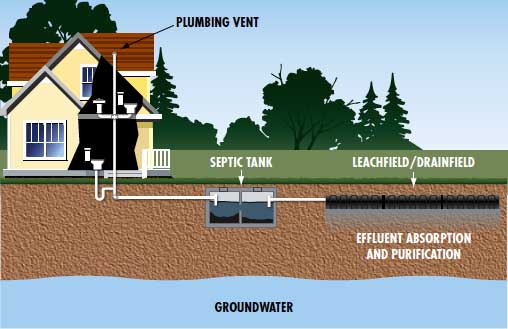Septic Services
Your septic system represents a considerable investment. Handling all your needs. Kerschner’s promptly and professionally handles complete system installations, simple repairs and inspections. With proper maintenance and by being more aware of daily living habits, you will greatly improve the life and health of your system.
What is a Septic System?
A septic system is a personal onsite wastewater treatment system (POWTS) that processes and purifies household waste (effluent). The effluent consists of blackwater (toilet wastes) and greywater (kitchen sink, bathtub and laundry wastes).
A septic system has two components: a septic tank and a leachfield or drainfield. Primary treatment occurs in the septic tank, where bacteria digest organic materials in the wastewater. The effluent then flows into the leachfield for secondary treatment. Here, bacteria complete the digestion and purification process as the wastewater slowly leaches into the soil.

Why the Tank Needs Pumping Periodically
Most of the solid waste that is in your septic tank is broken down by bacteria. The rest remains in the tank and builds up in sludge and scum layers. Consequently, your septic tank must be pumped out regularly. Otherwise, solids would eventually fill the tank and wash out into the leachfield. This is detrimental to the overall health and longevity of your system.
CAUTION: If solids do overflow from the septic tank into the leachfield, they will prematurely clog the soil pores. Pumping out the tank at this point will not restore the system. The most likely scenario would be installing a new leachfield in a different area, which can be expensive.
Having your system pumped by Kerschner’s every two or three years can help improve the longevity and keep your system working properly. If you have high water usage or a garbage disposal, you may wish to have your inspections be more frequent.
Tips for a Healthy Septic System
You can protect the performance of your system by controlling what goes into and through your septic system. Here’s how:
Inside Your Home
- Conserve water. Large volumes of water over a short period of time will flush untreated solids out of the septic tank and into the leachfield.
- Practice water conservation every day.
- Space out heavy water-using activities such as washing clothes and taking showers.
- Repair leaky faucets and valves. Consider replacing old toilets that use more water with new low volume fixtures.
- Keep your drains clean. Remember a septic system uses natural biological processes, so only biodegradable waste should go into it.
- No cigarette butts, tissues, sanitary napkins, disposable diapers, catbox litter, coffee grounds, or cotton swabs.
- No paints, oil, chemical drain cleaners, thinners, solvents, poison, or pesticides.
- No grease or cooking oils. Grease may harden on the top scum layer in the tank blocking the inlet or outlet. It may flow through to the leachfield and then harden, clogging the soil pores.
- Go easy with household chemicals. Disinfectants, ammonia, bathroom cleaners, bleach, etc. can kill the bacteria your system needs in order to work properly.
Outside Your Home
- Keep surface water away. Divert downspouts, driveway runoff, and sump pump discharge away from the leachfield. Landscape your yard to divert rainwater away. Excessive water keeps the soil in the leachfield from naturally cleansing the wastewater.
- Encourage the right plants. Grow grass or ground cover over the septic system to prevent soil erosion. Plant beneficial trees such as pines near the leachfield to help absorb water. Remove trees that like wet conditions. Their roots may penetrate and damage the leachfield.
- Be proactive in the care of your system. Learn the location of your septic tank. Keep a sketch of it handy with your maintenance record for service visits. Have your septic tank pumped and inspected regularly, approximately every two to three years, or as often as is appropriate for your system.
- Avoid physical damage.
- Don’t allow anyone to drive, park or compact the soil with heavy equipment over the system.
- Don’t dig in the leachfield or build anything over it.
- Don’t cover the tank or leachfield with concrete or blacktop.
Locating the Septic Tank
It’s very important to know where the tank is in order to have it inspected and pumped. Here are three different ways to find your septic tank:
- Ask to see the septic system permit for your property at your local zoning department. They will have a diagram of your system on it.
- See where your sewer line leaves your house; the tank should be about 10 feet outside the foundation.
- Have Kerschner’s probe with a steel rod, taking care to avoid damaging the tank or underground utilities.
Always Use Caution
Never go down into a septic tank! Toxic gases are produced by the natural treatment processes in septic tanks and can kill in minutes. Extreme care should be taken when inspecting a septic tank.
Stay Informed
Most problems with septic systems are due to lack of proper care. Call Kerschner’s any time you have a question, experience a problem with your system or if there are any signs of system failure.
Keep your septic tank cover accessible for inspections and pumping. Install risers if necessary. It’s helpful to keep a detailed record of repairs, pumping and inspections.
With a little attention, your septic system can be working properly for many years. Follow these simple tips and you’ll benefit the environment, as well as yourself.
Disclaimer: This site is for informational purposes only. It is not intended to be an authority regarding safety or regulatory issues. It is not to be an instructional medium and assumes no liability as it is intended for educational and informational purposes only.











